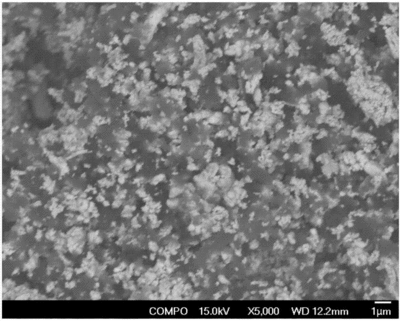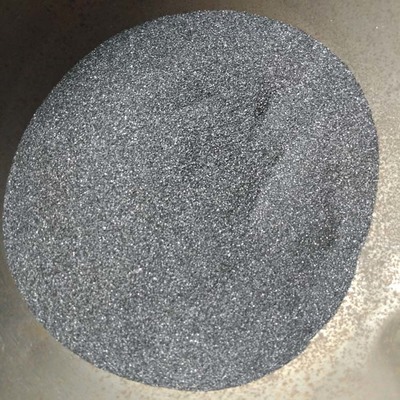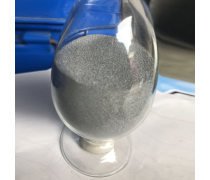The State of Carbide Compact Formation
After the carbide?compact is formed, it exists in a porous state. During the wet grinding process, the shape of WC is subjected to strong impacts, resulting in increased surface energy and enhanced reactivity. The longer the contact time of the compact with air, the greater the degree of oxidation, requiring more carbon for reduction. With the theoretical carbon content of carbide?remaining at 6.128%, the ratio of oxygen atoms to carbon atoms is 12/16. Therefore, for every additional unit of oxygen, it will consume 3/4 of the carbon content. This leads to the formation of the η phase more easily after alloy sintering.
The Existence of Oxygen in Carbide Mixtures
The oxygen content in the carbide?mixture can be considered to exist in three forms: occluded oxygen, cobalt surface oxygen, and oxygen in WO2 or WO3. Since the oxygen content measured by chemical oxygen determination includes the total of these three types of oxygen, it is difficult to determine their respective proportions in production. Therefore, this poses challenges to production. Additionally, oxygen enrichment in the environment is ubiquitous, so it is essential to manage each process reasonably in actual production.
Occluded Oxygen
Exists in the interstices of the compact and on the surface of the compact and mixture; generally removed by vacuum evacuation at the beginning of sintering, so it does not affect alloy sintering.
Cobalt Surface Oxygen
Due to the high susceptibility of cobalt to oxidation at room temperature, oxidation intensifies with increasing temperature. After wet grinding and subsequent drying, a layer of oxide film forms on the cobalt surface; the longer the material or compact is stored before sintering, the higher the degree of cobalt oxidation. This portion of the oxide requires carbon for reduction; before the temperature reaches 600°C during sintering, reduction mainly relies on free carbon, and the remaining unreduced oxides must be reduced by combined carbon. This portion of oxygen is critical to the carbon-oxygen balance during alloy sintering and is difficult to control.
WO2 or WO3 Oxygen
Also known as compound oxygen; before the carbonization of WC, WO3 gradually transforms into WO2 and then into tungsten powder (W), followed by carbonization. Some oxides may remain incompletely reduced or partially oxidized due to storage time, from W → W2C → WC, and may persist even after completion. Alternatively, inadequate protection during storage may lead to oxidation. These oxide residues are referred to as compound oxygen; the reduction temperature generally occurs before 1000°C, but severe oxidation may delay reduction until 1200°C. This oxide residue consumes carbon significantly, narrowing the margin for carbon levels and making it difficult to control sintering carbon content, thereby complicating the achievement of sufficient liquid phase formation.
The Form of Carbon in carbide
The carbon content in carbide?mainly exists in three ways: WC stoichiometry, carbon increment from binder decomposition, and carbon infiltration from furnace gases.
Generally, WC is adjusted according to the theoretical carbon content of carbide; reasonable carbon adjustment is made based on small samples before wet grinding; in the wax process, the carbon content is adjusted by subtracting the amount of carbon infiltrated from furnace gases and adding the amount of carbon consumed by oxides. In the rubber process, one-third of the rubber weight should be subtracted.
Carbon Increment from Binder Decomposition
During debinding and sintering, whether using wax, PEG, or rubber, there is more or less decomposition; thus, carbide?can gain carbon, although the amount of carbon increase varies with different binders. Since wax mainly relies on evaporation, it is generally considered not to increase carbon content. On the other hand, rubber and PEG rely on decomposition, with rubber decomposition occurring at higher temperatures, resulting in more carbon increase.

Carbon Infiltration from Furnace Gases
Since most heating elements, insulation layers, sintering plates or boats in carbide?sintering furnaces are made of graphite products, their effects become evident at 600°C; when sintering temperature rises above 1200°C, a large amount of carbon and CO released from graphite exacerbate carbon infiltration into carbide.
Impact of Cobalt on carbide?Properties
Cobalt has a hexagonal close-packed crystal structure, making it highly reactive and prone to oxidation. In WC-Co alloys, cobalt acts as the binder metal. When the cobalt phase exhibits the ε-Co crystal structure, with fewer slip planes (theoretically no more than 3), the alloy’s toughness is low. However, when the cobalt phase exhibits the α-Co crystal structure, the maximum number of theoretical slip planes can increase to 12, resulting in stronger fracture resistance. With increasing sintering temperature, the cobalt crystal structure shifts from hexagonal close-packed to face-centered cubic; the reverse occurs during cooling. Since tungsten dissolves more in cobalt, playing a “nailing” role, the transformation of crystal structure during cooling varies with the amount of tungsten dissolved.
Up to 1% of cobalt can dissolve in WC at room temperature; when the sintering temperature reaches between 400°C and 800°C, vigorous diffusion and rearrangement of cobalt occur. During this period, a lower amount of free carbon is more conducive to increased slip planes; this is advantageous in wax processes. However, rubber processes require completion of decomposition around 600°C, affecting the effective occurrence of cobalt phase slip planes.
At 1000°C during sintering, the oxide has almost completed the reduction process, so this stage is referred to as oxygen-free sintering. Carbon content in carbide?is generally tested at this stage; however, the so-called oxygen-free carbon contains only a minimal amount of oxygen. Nonetheless, oxide on the cobalt surface has been completely reduced by this point, and the edges of the cobalt phase have produced fewer liquid phases. At this stage, the compact has acquired some hardness, known as the pre-sintering stage. Products at this stage can undergo plastic processing if necessary.

Liquid Phase in Carbide
Theoretically, the liquid phase in WC-Co alloys appears at 1340°C. The temperature at which the liquid phase sufficiently appears varies with carbon content. As sintering temperature rises, the amount of liquid phase increases; fine WC particles gradually form a liquid phase. Intense shrinkage occurs in the product, reducing the distance between WC particles. Fine WC particles are gradually melted by larger particles, resulting in coarser WC particles. This phenomenon is known as grain growth. Grain growth during sintering is inevitable, particularly in ultrafine or submicron WC, where grain growth is more pronounced. To effectively inhibit excessive grain growth, inhibitors such as VC, TaC, and Cr3C2 can be added.
After sintering, undissolved WC and W2C rapidly precipitate, followed by ternary eutectic formation, laying the foundation for the alloy. The longer the cooling time above 1200°C, the more complete the precipitation, but the greater the opportunity for grain growth.

Fazit
The pursuit of ternary eutectic structures is the most critical aspect of sintering in WC-Co carbide. Ternary eutectic structures form the fundamental framework of carbide. In the W-C-Co ternary system, effective handling of WC grain growth, allowing more tungsten to dissolve in cobalt without decarburization, thereby improving the durability and toughness of carbide, is always the goal of alloy manufacturers. A German technical expert once said: “The essence of sintering lies in ‘high temperature and low carbon’.”









